#Tohoku Beer
Text
BIBLIOGRAPHY - “ANIME FOODIES: LAID-BACK CAMP THE MOVIE”
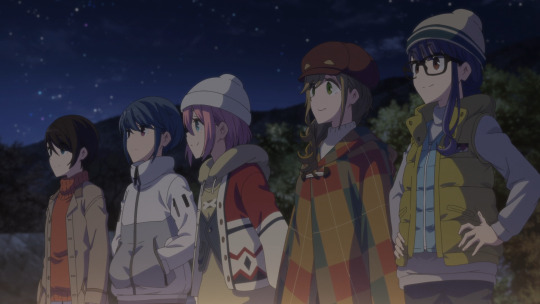
This is the bibliography for our entry in the Anime Foodies series of panels, “Anime Foodies: Laid-Back Camp The Movie”. The sources include not only places from which we garnered background of the food we were cooking, but also sources that helped us determine how to craft our own version of the recipes we were creating.
This is the second Anime Foodies panel which has a formal bibliography of sources. Those marked with double asterisks are regular sources we’ve used in all of the panels in the series and are a good starting point for anyone interested in Japanese food and its history.
Bibliography:
Afro. Laid-Back Camp. Vol. 6, Yen Press, 2019.
Afro. Laid-Back Camp. Vol. 7, Yen Press, 2019.
“Anethum graveolens L.” Royal Botanic Gardens Kew, https://powo.science.kew.org/taxon/urn:lsid:ipni.org:names:837530-1.
Baker, Liren. “Taco Rice: Okinawa Taco Rice” Kitchen Confidante, https://kitchenconfidante.com/taco-rice-okinawa-taco-rice.
“Braised Yuba (Tofu Skins) with Vegetables” Sunberry Jam, https://sunberryjam.com/braised-yuba-with-vegetables/.
“Buttered Beere 1588” Oakden, https://oakden.co.uk/buttered-beere-1588/.
“Dutch Oven Roast Chicken” Self-Proclaimed Foodie, https://selfproclaimedfoodie.com/dutch-oven-roasted-chicken/#wprm-recipe-container-33149.
“Dutch Oven Roasted Chicken with Vegetables” Camping Adventures, https://adventures.camp/dutch-oven-roasted-chicken-with-vegetables/.
“Finnish Salmon Soup (Lohikeitto)” Skinny Spatula, https://skinnyspatula.com/salmon-soup-lohikeitto/.
Friesen, Katy June. “Where Did the Taco Come From?” Smithsonian Magazine, https://www.smithsonianmag.com/arts-culture/where-did-the-taco-come-from-81228162/.
Greg. “Hot Buttered Rum 2 Ways AND Fat Washing! | How to Drink.” YouTube, uploaded by How To Drink, 23 Nov. 2019, https://www.youtube.com/watch?v=cCbEwyntSCM.
“Hokkaido Salmon Hot Pot (Ishikari Nabe) 石狩鍋” Just One Cookbook, https://www.justonecookbook.com/salmon-hot-pot/.
“Hoto Noodle Soup from Yamanashi ほうとう” Just One Cookbook, https://www.justonecookbook.com/hoto-noodle-soup-yamanashi/#wprm-recipe-container-79243.
“Hōtō Noodle Soup (Hōtō Nabe)” RecipeTin Japan, https://japan.recipetineats.com/hoto-noodle-soup-hoto-nabe/.
“Houtou (ほうとう)” Food in Japan, https://www.foodinjapan.org/kanto/yamanashi/houtou/.
“How to make Houtou – Yamanashi local speciality noodle dish recipe” Japanese Cooking Class Tokyo, https://japanesecookingclasstokyo.wordpress.com/2014/01/03/how-to-make-houtou-yamanashi-local-speciality-noodle-dish-recipe/.
“How to Make the Best Tempura 天ぷら” Just One Cookbook, https://www.justonecookbook.com/tempura-recipe/.
Hua, Charlie. “Kiritanpo: Trying out one of Akita’s local specialties” Japan Travel, https://en.japantravel.com/akita/kiritanpo/55809.
“Hypomesus olidus” FishBase, https://fishbase.de/summary/Hypomesus-olidus.html.
“Hypomesus olidus” Integrated Taxonomic Information System – Report, https://www.itis.gov/servlet/SingleRpt/SingleRpt?search_topic=TSN&search_value=162031#null.
**Ishige, Naomichi. The History and Culture of Japanese Food. London, Kegan Paul Limited, 2001.**
“"Ishikari" Salmon Hot Pot (Ishikari nabe)” NHK World – Japan, https://web.archive.org/web/20201101192650/https://www.nhk.or.jp/dwc/food/recipe/kyou_12310.html.
“Ishikari Nabe Recipe (Salmon and Miso Hot Pot in Hokkaido)” Cooking With Dog, https://cookingwithdog.com/recipe/ishikari-nabe/.
“Japan-Mexico Relations (Basic Data)” Ministry of Foreign Affairs of Japan, https://www.mofa.go.jp/region/latin/mexico/data.html.
“Kiritampo Nabe (Rice Stick Hot Pot)” NHK World, https://web.archive.org/web/20180318093216/http://www.nhk.or.jp:80/dwc/recipes/detail/138.html.
“Kiritanpo (きりたんぽ)” Food in Japan, https://www.foodinjapan.org/tohoku/akita/kiritanpo/.
Laid-Back Camp. Directed by Yoshiaki Kyougoku. C-Station, 2018.
Laid-Back Camp Season 2. Directed by Yoshiaki Kyougoku. C-Station, 2021.
Laid-Back Camp The Movie. Directed by Yoshiaki Kyougoku. C-Station, 2022.
Miller, Max. “Making 400 Year Old Buttered Beere.” YouTube, uploaded by Tasting History with Max Miller, 10 Mar. 2020, https://www.youtube.com/watch?v=ZlMhZvOX2ps.
“Motsunabe” Japanese food style, https://jpnfood.com/recipe/meat/motsunabe.
“Motsunabe: How to Eat and the Best Restaurants in Fukuoka” Savor Japan, https://savorjapan.com/contents/discover-oishii-japan/motsunabe-how-to-eat-and-the-best-restaurants-in-fukuoka/.
“Motsunabe recipe もつ鍋” The Japanese Food Lab, https://thejapanesefoodlab.com/motsunabe/.
“Motsunabe (もつ鍋)” Food in Japan, https://www.foodinjapan.org/kyushu/fukuoka/motsunabe/.
“Okinawa Taco Rice and Cheese (Cafe Style)” Sudachi Recipes, https://sudachirecipes.com/okinawa-taco-rice/.
“Okinawa Taco Rice (Video) タコライス” Just One Cookbook, https://www.justonecookbook.com/taco-rice/.
“Recipe of Speedy Lightly Flavored! Hakata-style Motsunabe (Offal Hot Pot) with Soy Sauce Based Soup” Ground-Skillet, https://ground-skillet.web.app/734-recipe-of-speedy-lightly-flavored-hakata-style-motsunabe-offal-hot-pot-with-soy-sauce-based-soup/.
“Salmon Hot Pot (Ishikari Nabe)” RecipeTin Japan, https://japan.recipetineats.com/salmon-hot-pot-ishikari-nabe/.
“Salmon Soup” Happy Foods Tube, https://www.happyfoodstube.com/salmon-soup/.
Sam. “Aburi Technique for Fish” Chef Epic, https://chefepic.com/aburi-technique-for-fish/.
“Seared Salmon Sushi (Aburi)” Cooking with Cocktail Rings, https://cookingwithcocktailrings.com/seared-salmon-sushi-aburi/.
**Singleton Hachisu, Nancy. Japanese Farm Food. Kansas City, Andrews McMeel Publishing, 2012.**
**Singleton Hachisu, Nancy. Preserving the Japanese Way. Kansas City, Andrews McMeel Publishing, 2015.**
“【Smelt Tempura】 How to make Smelt tempura With technical explanation to stand fins” YouTube, uploaded by 逢禅天ぷらチャンネル / AIZEN TEMPURA CHANNEL 1 Oct. 2020, https://www.youtube.com/watch?v=H3KTXNGGAL4.
“Soy Milk Hot Pot 豆乳鍋” Just One Cookbook, https://www.justonecookbook.com/soy-milk-hot-pot-tonyu-nabe/.
“Taco Rice (タコライス)” No Recipes, https://norecipes.com/okinawa-taco-rice/.
“Tentsuyu” Oishi Washoku Recipes, https://www.oishi-washoku-recipes.com/tentsuyu.
“‘Tentsuyu’ (Tempura Dipping Sauce)” Hiroko’s Recipes, https://www.hirokoliston.com/tentsuyu-tempura-dipping-sauce/.
Turkell, Michael Harlan. “Foil Yaki Is the Best” Taste, https://tastecooking.com/foil-yaki-best/.
U.S. Fish and Wildlife Service. Wakasagi (Hypomesus nipponensis): Ecological Risk Screening Summary. 8 Nov. 2019, https://www.fws.gov/sites/default/files/documents/Ecological-Risk-Screening-Summary-Wakasagi.pdf.
“What is the “King Tacos” which is loved by Okinawan?” Okinawa Labo, https://okinawa-labo.com/en/okinawa-taco-rice-1966.
**Wondrich, David. Imbibe! From Absinthe Cocktail to Whiskey Smash, A Salute in Stories and Drinks to “Professor” Jerry Thomas, Pioneer of the American Bar. Updated and Revised Edition. New York City, TarcherPerigee, 2015.**
“〆まで美味しい ごま豆乳鍋つゆ ストレート” Mizkan, https://www.mizkan.co.jp/product/group/?gid=07101.
“簡単タコライス” Lettuce Club, https://www.lettuceclub.net/recipe/dish/22978/.
“王道タコライス” Delish Kitchen, https://delishkitchen.tv/recipes/196315721972580774. “簡単!すぐ出来!タコライス レシピ・作り方” Kurashiru, https://www.kurashiru.com/recipes/80ca4e93-29d6-422a-8168-cf409ac46d23.
#nos anime#camping food#camping#food#laid back camp#yuru camp#anime#anime foodies#anime food#yurucamp#laid back camp the movie#anime bibliography#bibliography
31 notes
·
View notes
Text
JUN KOJIMA: Star Nocturna
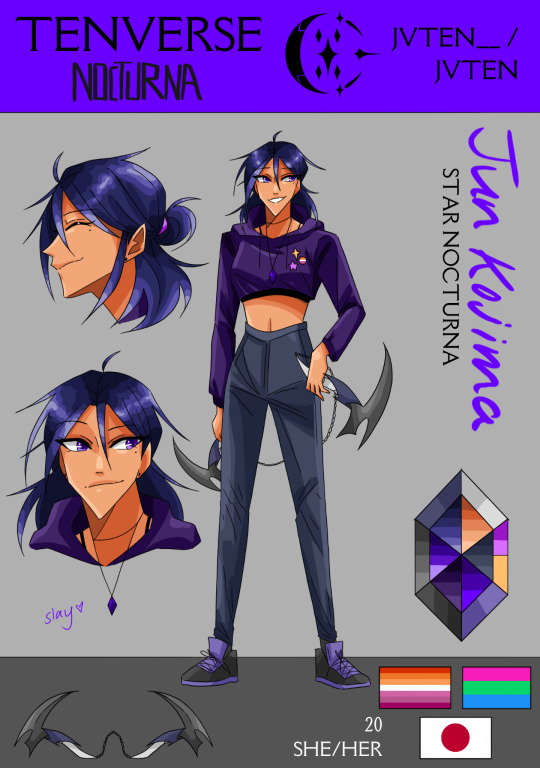
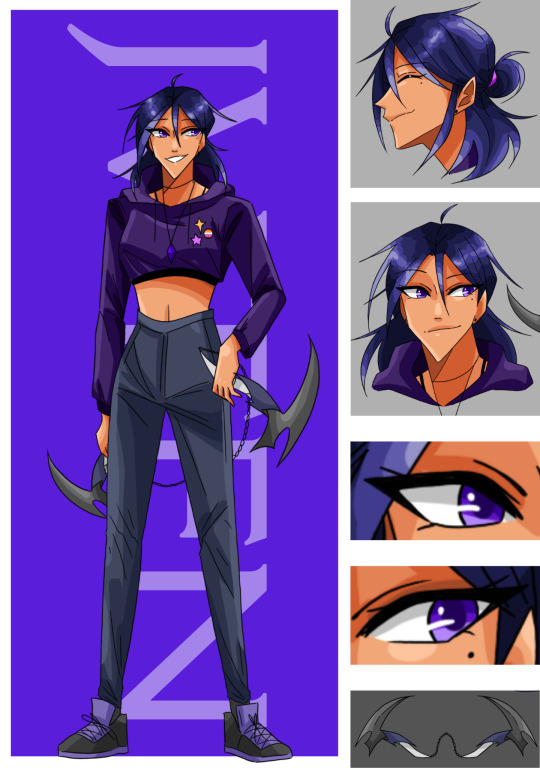

JUN KOJIMA, an aspiring journalist whose life had been affected by the Tohoku earthquake and tsunami, finds herself torn between her job aspirations at home and her eventual goal to find her best friend Kazu Tachibana who had mysteriously disappeared. The Tohoku earthquake and tsunami in 2011 had taken away both Jun and Kazu’s parents, meaning they only had each other for a long time. And with Kazu gone missing, Jun didn’t know what to do with herself… at least until she one day found Kazu’s hidden research on something called a halo crystal… and using all his findings she found a world parallel to theirs, only filled with anthropomorphic animals with human-like sentience.
Jun had found Kazu who had become a boss of the mafia clan Arakan, but it had appeared he had given up hope on humans, because they had treated him and Jun like dirt during their childhood. By the end of their arc, Jun had convinced him that he should at least give humans one more chance. Even as they became Nocturna, working with the Vanguard and Jotunhel, Jun was all the more confident that Kazu could eventually forgive humans.
Now, with Jun as one of the Nocturna, she remains bubbly, kind and outgoing, however her training leads her to realise just how many worlds and universes there are… and how magic can ultimately affect a person…
PERSONALITY: Bubbly, kind, outgoing, determined, encouraging, ditzy
WEAPON: Twin claw scythes
POWERS/ABILITIES:
Shapeshifting: can turn into a black cat
Star manipulation: can control nebulas and ultimately control the energy from neutrons/electrons/whatever to create bright bursts of energy
Enhanced flexibility
Telekinesis
Weapon summoning
VOICE CLAIM: Anne Hathaway
See you at the next character sheet!
#no this was not 6 hours late wdym#oc reference#oc reference sheet#character reference#character reference sheet#oc#oc ref#oc ref sheet#original character#original character design#oc stuff#jay draws#my oc#my art#art#lesbian character#polysexual character#lesbian oc#polysexual oc
3 notes
·
View notes
Text
やってます。
Tun.

えんでかしの野郎、東北行くなんつってたけど音沙汰ねえな。どうせ遊び呆けてんだろ?なんてお思いでしょう。ところがどっこい、ちゃんと仕事してましたよ。伊達に嫁に許しもらってねえすよ?
Haven't heard from Endekashi, the guy who said he was going to Tohoku. He's probably just playing around, isn't he? You must be thinking, "Oh, no, But on the contrary, he was working. I didn't get his wife's permission, did I?
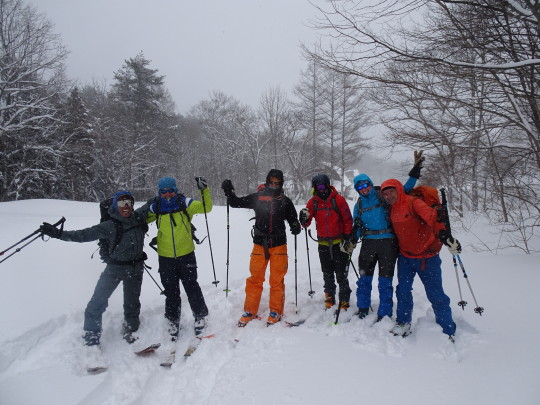
実は今回岩手に来たのは理由がありまして、こちらのドイツからお越しのご一行様をガイドするという仕事があるのです。仕事ですよ仕事。遊んでるばっかじゃないんですからね!
Actually, there is a reason why I came to Iwate this time. I have a job as a guide for a group of people coming from Germany. It's work, work, work. I'm not just playing around!
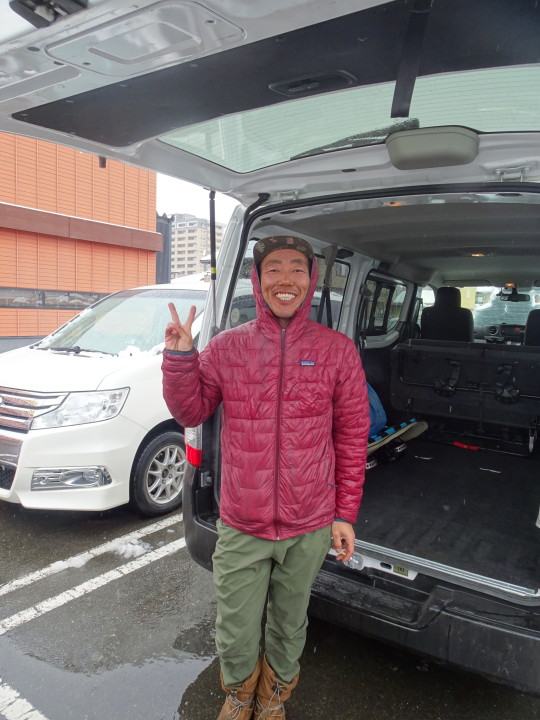
岩手といえばこの男。Iwate Backcoutry Guides の高橋孝精。そのまま今週末は岩手、秋田辺りでコラボツアーの予定です。ご都合合う方!是非とも!!
Speaking of Iwate, this man is Kosei Takahashi of Iwate Backcoutry Guides. I will be collaborating with him on a tour around Iwate and Akita this weekend. If you can make it! We look forward to seeing you there!

白馬同様、二月は結構雨にやられてなかなか厳しいコンディションっだったそう。しかし、3月に突入した途端、冬将軍様のお帰りです。降りすぎで高速止まってました。仕方なく迂回した下道もスッゲー風でスリリングなドライブを味わいました。
As in Hakuba, the conditions in February were quite severe due to the rain. However, as soon as March arrived, General Winter returned. It snowed so much that the highway was stopped. We had no choice but to take a detour and enjoyed a thrilling drive on the downhill road with storong wind.

俺も初めて行く山。新雪の量からして楽しみです。
It's my first time going to this mountain too. I'm looking forward to it, given the amount of fresh snow.

岩手の前に北海道へ行ってきたそうで。しかしながら、あの北海道で全然パウダー滑られなかったそうです。今日は間違いなくありつけそうですよ。
They went to Hokkaido before Iwate. However, They could not to ski powder at all in Hokkaido. Today, They will definitely find it.

このルート、途中に神社があるのです!なんと日本を感じられるルートなのでしょう!
お邪魔致します。
This route has a shrine on the way! What a route to feel Japan!
Let me interrupt you.

頂上付近は風も強く真っ白な世界。
Near the summit, the wind was strong and it was a white world.
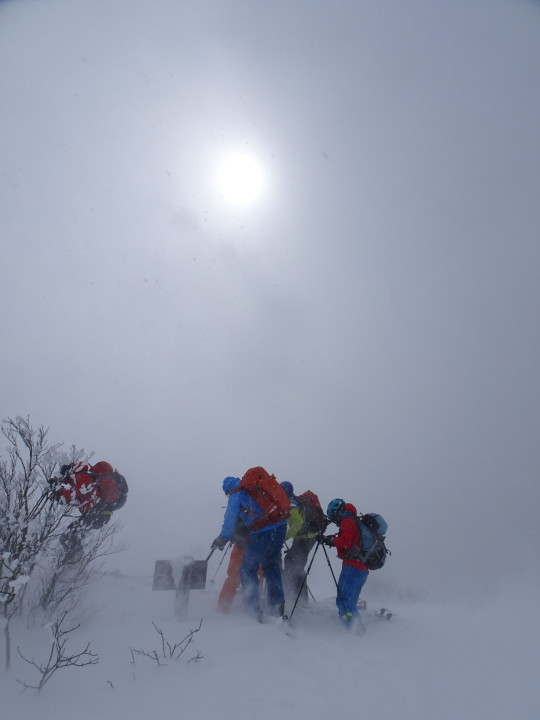
ピークへ到着!しかし、爆風ですっ飛ばされそう!ちょっと風をかわす降りたところで準備しましょう!
Arrived at the peak! But we are about to be blown away by a blast of wind! Let's get ready to go down to dodge the wind a bit!

ふぅ〜、ここの方が全然マシです。そんじゃ行きましょー!
Oh, this place is much better. Well then, let's go!

ふけええええ!!!
DEEEEEEEEP!!!

くそさみいでけあって雪も極上です。
It's f cking cold and the snow is superb.

あんまり期待しないで行った山が予想以上に良くて我々もびっくり。しかもすぐ近くに温泉まであって完璧な流れです。
思わず彼らの中で、POB(Powder Onsen Beer)なる流行語が生まれてました。
We went to the mountain not expecting much, but we were surprised to find that it was better than expected. And the hot springs nearby were perfect.
They unintentionally created a buzzword, POB (Powder Onsen Beer), among them.
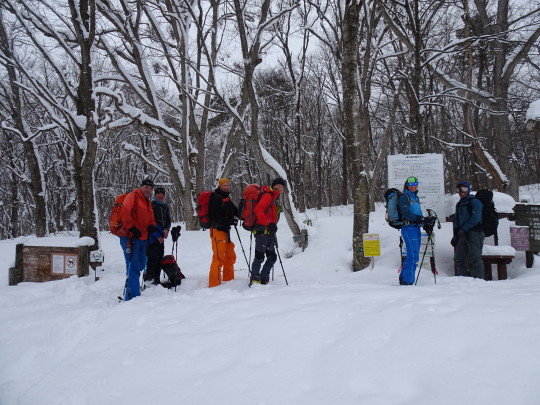
続いて二日目、昨日に引き続き今日も雪で風もある予報。風をかわす林のルートへ行ってみました。
On the second day, snow and wind were forecast for today as yesterday. We went to a forest route to shelter from the wind.
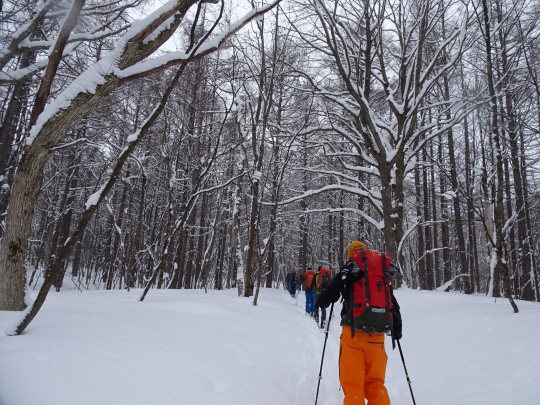
初めはなだらかな林を延々と歩きます。
雪は昨日と比べたら重めです。
At first, we walked for a long time through a gently rolling forest.
The snow is heavier than yesterday.

立派な滝の前で一枚。パシャリ。俺と肩くむ為に大分、かがんでいただいてるようで申し訳ありませんね〜。
普段は1月半ばには凍るという滝もジャバジャバ水が流れてました。
A shot in front of a magnificent waterfall. A quick snap. I apologize for bending down so much so that you can rub shoulders with me.
The waterfall, which usually freezes over in mid-January, was flowing like water.

さーて徐々に斜度が増していきますよ〜。
Well, the slope is gradually increasing.

えっさほいさ。
Eh-sa-hoi-sa.

よーしこの辺から行ってみますか。
Okay, let's go from here.

いやっほー!!
Yee-haw!

ちょっと薮がうるさいとこがありますね〜。
The bushes are a bit noisy.

やっと開けたと思ったらあまり斜度がなくなってきてしまいました。
When it finally opened up, there wasn't much slope left.

イェーイみんな!写真撮るよー!明らかにあまり盛り上がってない面々。むう…。しかし、まだ早いし、この上しか滑るとこないし、もう一本行きますか…。
Yay guys! I'll take a picture! Obviously, not very excited people. Ummm…. But it's still early, and there's no other place to ski but up here, so let's go for another run….

しかし登り始めればまたいつの間にか、何かの話題で盛り上がっている皆さん。いいヴァイブスです。
But if they start climbing, before they know it, They will all be talking about something again. Nice vibes.

よーしこい!いいぞ!
彼らはバックカントリー好きの集まりで、2年に一回こうした海外のバックカントリートリップに行っているらしく、その模様を映像作品にしているそうです。そんなの最高に決まってんじゃん!
Yo, come on! Nice!
They are a group of backcountry enthusiasts who go on these overseas backcountry trips once every two years, and they are making a video production of it. That's just the best, right?
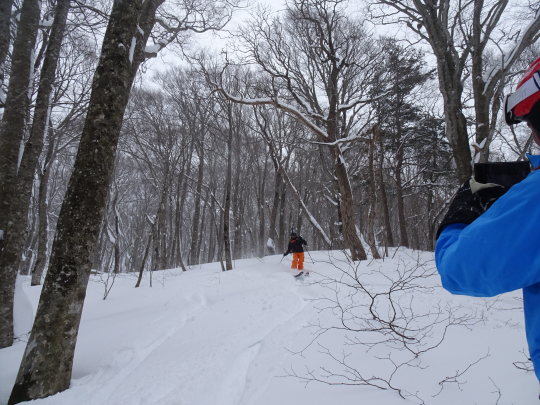
世代も超えたメンバーが集まり、みんな本当に楽しそうです。
Members of all ages gather together, and everyone seems to really enjoy themselves.

あ〜楽しかったね〜、おし!温泉だ!
Ahhhh, that was fun…oshi! It's a hot spring!
P!O!B!(Powder! Onsen! Beer!)
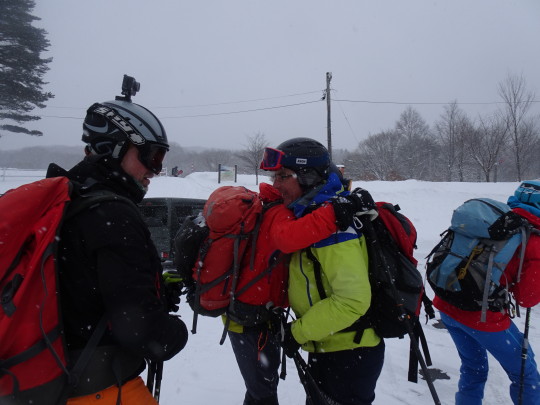
下山したらみんなハグしあってお互いの頑張りを讃えあう。なんて素敵な光景でしょう。
After descending the mountain, everyone hugged each other and praised each other's efforts. What a wonderful sight!
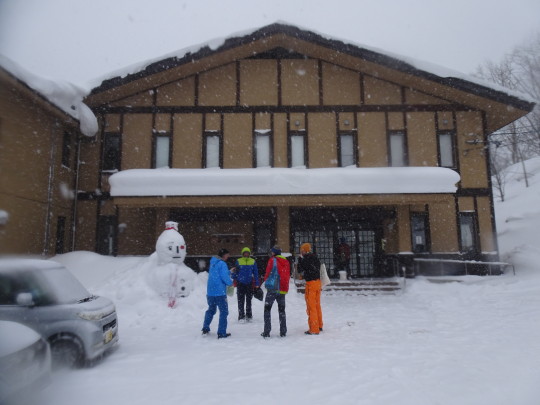
今回は松川温泉峡雲荘へ行きました。露天風呂への道がなんともいえない味のあるいい風呂です。
ここで悲しいニュースが一つ。ここ松川温泉で一番ディープな魅力を放っていた松風荘が営業をやめてしまったそうです。マジかよ〜。切なすぎる。誰かお金持ちな人、やってくれませんかねえ〜?
This time I went to Matsukawa Onsen Kyounso. The path to the open-air bath is indescribably tasteful and nice.
Here is a sad news. Matsukawa Onsen's deepest attraction, Shouhuso, is no longer in business. Seriously? Too sad. Will someone with money please do it?
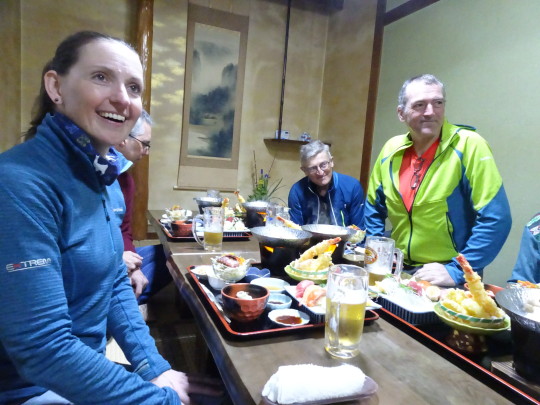
夜は美味しい日本食に舌鼓。
さて、明日からちーと泊まりで山行ってきます。
その模様はまた下山してから。
お楽しみに〜。
In the evening, we enjoyed delicious Japanese food.
Well, I'm off to the mountains for a little overnight stay starting tomorrow.
I'll tell you how it goes after we get back down the mountain.
Please look forward to it.
0 notes
Text

The area around Ameyoko shopping street, located under the elevated railway tracks between JR Ueno Station and Okachimachi Station one stop south of the station, is known for its many tasteful restaurants. Although the area around Ueno Station has been modernized, there are still some stores in this corner that retain the “melancholy” atmosphere of Ueno, which once existed as a gateway to the Tohoku and Joetsu regions, and continue to do their best to keep their businesses open.
Among the stores in the Ameyoko area, I went to Chinchinken, a store that has recently been featured on YouTube and other media, around 9:00 p.m. one weekend night. I have passed by the restaurant several times before, but it has a very Southeast Asian and deep atmosphere, and I feel like I could drink a beer just from that…
Continue reading... >> Chinchinken Ueno
0 notes
Text
{:en}Be Easy Mezame by Be Easy Brewing{:}{:ja}ビー・イー・ジー・ブルーイング:ビー・イー・ジーメザメ{:}
Be Easy Mezame : someone, somewhere is making horseshoe sounds with coconuts.・ビー・イー・ジーメザメ:馬の音が聞こえますか。
#craftbeer #beer #クラフトビール #地ビール #ビール
{:en}Be Easy Mezame is a 7% lager from Be Easy Brewing, based in Hirosaki, in Aomori, Japan. It’s part of the draft lineup, though it found its way into bottles during 2020. Be Easy Mezame is brewed using imported coconut and contains honey malt.
Be Easy Mezame Aroma and Taste
Be Easy Mezame poured out a hazy dark golden orange colour with a plump white head on top with lots of fluffy bubbles on…

View On WordPress
1 note
·
View note
Photo





#travel#journey#vacation#2019#Tohoku#Miyagi#meal#Kesennuma#sightseeing#eat#food#delicious#yummy#Japan#Japanese food#beer#sashimi#tenpura#washoku#dinner#旅行#観光#東北#宮城#気仙沼#お刺身#ビール#天ぷら#ホヤ#カツオ
155 notes
·
View notes
Photo

「美味い!」 #ビール #地ビール #クラフトビール #beer #craftbeer #盛岡中央公園 #moriokacentralpark #メルツェン @takuji.onodera.morioka.iwate 盛岡市鉈屋町に「ととと 盛岡の泊まれるたまり場」 2019年夏オープン予定 ブログも見てね! http://bokunohosomichi.fun/blog/ #岩手 #盛岡 #iwate #morioka #ゲストハウス #guesthouse #東北 #tohoku #行くぜ東北 #行くぜ岩手 #岩手旅行 #盛岡旅行 #東北旅行 #hostel #iwatetrip #moriokatrip #japantrip #tohokutrip #泊まれるたまり場 #ととと https://www.instagram.com/p/BxUIDRzlC_C/?utm_source=ig_tumblr_share&igshid=7ssb59f2lu6e
#ビール#地ビール#クラフトビール#beer#craftbeer#盛岡中央公園#moriokacentralpark#メルツェン#岩手#盛岡#iwate#morioka#ゲストハウス#guesthouse#東北#tohoku#行くぜ東北#行くぜ岩手#岩手旅行#盛岡旅行#東北旅行#hostel#iwatetrip#moriokatrip#japantrip#tohokutrip#泊まれるたまり場#ととと
0 notes
Photo

Love a good torii. This belter sits near the foot of (too many) steps that lead up to Futaarayama Shrine in the city of Utsunomiya, Tochigi Prefecture.
We'd spent the afternoon bussing it around the city after sampling (for press) JR East’s updated “Gran Class” carriage service on the Tohoku Shinkansen on the way up.
Futaarayama Shrine was one of the last spots we visited in town. On the back of a beer and a plate of gyoza we weren't up to joining in on the sprinting races that some bored students were holding up and down the shrine steps (of which there are a lot). - Spring, 2019
https://www.city-cost.com/blogs/City-Cost/wk4p0-living_utsunomiya_shi_tochigi
#travel#japan#utsunomiya#shrine#japanese culture#life in japan#japan pics#love japan#Street Photography#tumblr japan#japan photography#travel photography#asia#japan asia
11 notes
·
View notes
Text
Knights in White Lycra
Words by Susan Burton
Why a group of foreigners bicycle to Fukushima every year – and what this says about charitable giving in Japan
The Knights ride out from Tokyo on the Friday evening bullet train, their bicycles dismantled and stowed in the obligatory rinko carry-on bags. They overnight in Takasaki city in Gunma Prefecture and the following morning they rise early to begin their quest – to ride 500 kilometres in four days to the Aiikuen Children’s Home in Fukushima prefecture and to raise money for the 72 children who live there.

In the peloton this year there are 42 riders from 14 different countries, ranging in age from 23 to 63. Twenty-six are attempting the ride for the first time. They are grouped together in seven teams of six, by experience, ability and willingness to stop for lunch. Each group is led by an able, veteran Knight.
Rob Williams (53, works in finance) is the Knights’ spiritual leader. In 2012, he and a group of fellow British expatriates were slumped disconsolately in the Hobgoblin pub in Tokyo staring at their beer guts. They concluded that they either needed to stop drinking or take up some form of exercise. They chose cycling because, “Brits are good at sport that involves sitting down.” There was also a more serious side to their quest. Following the Great East Japan Earthquake and nuclear disaster in March 2011, several of them had made repeated trips into the disaster area delivering emergency aid and public donations. But a year on, many places still lacked even basic necessities. One of these was Minamisoma, a city 25 kilometres north of the Fukushima Daiichi Nuclear Power Plant. Minamisoma was partially destroyed by the tsunami and most of the surviving residents were forced to relocate outside the 30-kilometre mandated radiation evacuation zone. In April 2012, when the zone was reduced to 20 kilometres, some residents had been allowed to return but many still had no electricity, running water or medical facilities.
That evening in the Hobgoblin pub, Rob and his friends decided they would cycle to Minamisoma to raise money to supply the residents of the city’s temporary accommodation with food and drinking water. Later in a karaoke bar someone stood up and sang the Moody Blues song, and the Knights in White Lycra (KIWL) were born. Their motto: get fit and give back.
Rob is also one of the ride’s team leaders this year. His team are strictly A to B cyclists, speeding to their destination in the shortest possible time. For lunch he allows them eight minutes to grab rice balls and Pocari Sweat drinks from the local convenience store.
Andy Abbey’s group prefer to stop for a sit-down lunch at a café or roadside noodle bar. Andy (British, 47, works in management consultancy) joined the Knights in its second year. Hours after the earthquake, a Facebook page called Foreigner Volunteers (now Foreign Volunteers Japan) appeared calling for contributions and helpers. Their first donation was a case of baked beans. When they had filled six two-tonne trucks, Andy and several other foreigners drove north. Recalls Andy, “Everything was just flat. It was terrifying.” The tsunami had swept away houses, cars and people up to 5 kilometres inland and 200 kilometres all the way up the east coast of Japan. Compounding the catastrophe was the nuclear radiation which was spewing from three exploded reactors and spreading unchecked on the spring winds and coastal currents. “It was very obvious that this was an unmanageable situation,” says Andy. Some foreigners went north only once, too traumatised by what they had seen to go back. Andy made repeated trips to the disaster areas. But he wanted to do more. He’s now a member of the KIWL committee.
Miho Inosaki (Malaysian-Japanese, works in public relations) is in Andy’s group. At 23, she is the youngest and least experienced rider and one of only five women in the peloton. She first encountered the Knights when she was tasked by her company Custom Media, one of the Knights’ sponsors, with filming their annual promotional video. Before becoming a ‘Knightess’, she had never cycled before and she averages one crash every third time she gets in the saddle. Within five minutes of picking up her new bicycle for this year’s ride she collided with a motorcycle. (During the ride, she somersaults over her handlebars and hits her head on a fence post.)
Egon Boettcher (New Zealander, 48, works in banking) leads another group and plans the Knight’s route, a difficult task due to Japan’s mountainous terrain and the fact that the ride takes place during the rainy season. Japan also has the world’s highest incidence of earthquakes, but the Knights have been fortunate. Earthquakes tend to strike in areas Egon has just left. This year, a magnitude 6 rattles Niigata two days after the Knights’ departure.
In previous years, the Knights had started their quest in Nihonbashi in central Tokyo but with heavily congested streets and numerous traffic lights it took more than three hours to clear the metropolis. Now they take the train and begin in another prefecture. This also enables them to vary the journey every year and to make it a challenge worth sponsoring. Tokyo is only 300 kilometres from the Fukushima Daiichi Nuclear Power Plant, a distance that has been imprinted on every Tokyo resident’s mind since the plant’s meltdown. (By comparison, Chernobyl is over 2,000 kilometres from London.)
On the first day, the Knights cycle from Takasaki to Yuzawa in Niigata prefecture, a distance of 55 kilometres in 27-degree Celsius heat under a sun unobstructed by a single cloud. The journey takes them through the Japanese countryside in early summer, past flooded rice fields sprouting green shoots and to a height of 1,200 metres, in sight of mountains from which the snow has yet to melt.
They spend the first night in the town of Yuzawa, in a mountainous region of Niigata prefecture known as ‘snow country’. Their lodgings, a resort called Twin Towers, is a complex of privately-owned apartments developed during the economic boom in the 1980s. More than two decades into an economic recession, many of the owners are unable to sell and now rent out the rooms to cover exorbitant maintenance charges. There are few guests in green season. Andy appears to have the 11th floor to himself. Egon rattles round a duplex penthouse that he learns was refurbished for the Emperor and Empress during the 1998 winter Olympics in nearby Nagano (but they never stayed there). “We never saw a soul who wasn’t with us,” says Egon. “It was like the Shining.”
On the second day, they pedal further north to Niigata city on the Sea of Japan along routes lined with lush spring greenery and across wide bridges spanning streams that will swell into torrents in a matter of hours. With the rainy season approaching, a searing heat reflects off the tarmacked roads and a thick, stifling humidity envelops the riders.
Rainy season arrives on the morning of the third day, bringing 50-kmh head and cross winds. Three riders are blown off their bikes on the 150-kilometre journey to Aizu Wakamatsu, where the riders ease their aching limbs in the steaming onsen (volcanic hot spring). In case of accidents, injuries and punctures, the riders are followed by two support cars. Padded cycle shorts and ‘bum butter’ are essential on the road. But a soak in a hot spring eases the muscles at the end of the day. And that’s one good thing about having so few women on the ride, notes Miho. There’s always plenty of room in the women’s onsen.
On the fourth and final day, the winds have blown themselves out but the rain continues to trickle down the backs of windcheaters and seep into microfibre shoes. The morning begins with a long climb to a plateau on which sits Lake Inawashiro, the fourth-largest lake in Japan, also known as the Heavenly Mirror Lake because of the glass-like clearness of the water. The sun reappears just as the riders reach the Aiikuen Children’s Home which is situated south of Fukushima city and, gallingly for the exhausted riders, at the summit of one of the ride’s steepest hills. As they round the final bend, the excited children are waiting to greet them, waving flags of the Knights’ home countries and stretching out their hands for high fives. “It was just a wonderful moment,” says Miho later. “Just this overwhelming feeling of emotion where you went, ‘Oh my god, that’s why we do it.’” The riders dismount and the children, aged from 2 to 18, rush up. They want to know all about the Knights’ road bicycles. One little boy tries on Andy’s cycling helmet. “He decided I was his best friend and would show me the children’s home,” Andy recalls. The riders are led by the children into the gymnasium where they sit cross-legged on the floor to listen to a speech of thanks.
Aiikuen was founded in 1893 by Uryū Iwako (1829-1897), an orphaned daughter from a merchant family who dedicated her life to the improvement of living conditions for ordinary people. Situated 49 kilometres away from Daiichi, the orphanage is outside the evacuation zone. But because it stands on a hill facing the plant, when the reactors blew, its seven hectares of thickly-forested grounds – sports field, campsite and lawn – were coated in caesium-137. The prefectural government paid to have Aiikuen cleaned, hosing down the modern concrete buildings, removing grass and chopping down trees. But hotspots remained and for several years after the disaster Aiikuen staff (like many parents in the Tohoku region) limited the children’s outdoor playtime. They also tested food for contamination and regularly checked the children’s health. The immediate danger may have passed but Aiikuen still needs more support, which the government is slow to provide.
Nationwide, only ten per cent of approximately 30,000 children in care are orphans. The rest have been removed from neglected or abusive homes or given up by families who are unable to care for them financially. Fostering and adoption remain rare in Japan because parents must give legal permission for their child to be cared for by someone else and for cultural reasons – predominantly loss of face – they are unlikely to agree to this. Adoption is registered on the koseki (the family register) which is a publicly available document, and the stigma of having an adoption in the family bloodline (suggesting an unplanned pregnancy or a lack of financial stability) can affect job and marriage prospects. Less than ten per cent of children in welfare are fostered or adopted. Most remain within the welfare system long-term (just under half live in children’s homes for more than five years), sometimes with little or no parental contact. They are termed ‘throwaway children’, trapped in a legal limbo until they must leave at 17 or 18.
The attitude of some Japanese towards marginalised and disadvantaged groups is not always sympathetic, and the needs of children in care homes is not an issue that many Japanese wish to look at too closely. Says Andy, “I think there’s a blanket assumption here that the government takes care of everything. That’s good in some respects because generally the government kind of does but when something goes wrong – and the Tohoku earthquake was a perfect example – the government literally couldn’t take care of everything. No government could take care of that. It was impossible.” This is why KIWL has focused its money-raising efforts on children’s charities, in particular grassroots organisations for whom even a small amount of money can make a big difference.
In the gymnasium, the children present the Knights with certificates of appreciation printed by Aiikuen’s Digital Citizenship Club on its laser printer. With little or no parental support, a university education is impossible for young people coming out of the care system and they risk falling into low level work in factories or the sex industry. One goal of Aiikuen is to educate the children in skills that may enable them to find fulfilling jobs when they leave, particularly in the technology industry. During the ceremony, word arrives that the Knights’ cycle ride has raised just over ten million Yen (£75,000) for YouMeWe, the charity which supports the home. It will help to pay for more computing equipment and training in digital skills such as coding and video editing.
Most of the ten million Yen comes from corporate sponsorship. The Knights’ major sponsors are the international companies for which many of the riders work. This year, alongside the Knights’ logo (a plumed helmet and a shield depicting linked hands) there are 26 sponsor names on the riders’ jackets including Netflix, World Family, Land Rover, Boyd & Moore Executive Search and Allied Pickfords, companies which reflect the transient nature of expatriate life in Japan. In western countries, sponsoring someone to do a sporting challenge is a recognised way of raising money for charity. Egon’s first sponsored event at age 8 was cycling round and round a school track on a Raleigh bicycle. But in Japan there is no concept of the sponsored event. When Miho asked friends to sponsor her they were confused. “I got questions like, ‘Why would I pay you to do sports?’” In Japan, charitable giving more commonly takes the form of volunteering in the local community and doing chores – such as managing rubbish collections, street cleaning and watching over elderly residents – for your neighbourhood association. “It’s not that there’s no charitable spirit,” says Andy. “It’s just expressed in a different way.” 3/11 was a disaster on an unprecedented scale and many Japanese reacted immediately, collecting donations from friends and neighbours and forming residents’ groups to travel to the disaster area to provide volunteer labour. But paying foreigners to bicycle there was perplexing. Toru Akiyama, one of the five Japanese riders and at 63 the group’s oldest Knight, had to work hard for the money he raised from friends and colleagues. “He had to explain individually, this is what a sponsored event is,” says Miho. One result of the Fukushima disaster is that the number of charities seems to be increasing along with a shift in understanding about the many ways that donations can be raised. The 500-kilometre sponsored ride is not the only sporting challenge the Knights take on. There are marathons, pub quizzes, golf, futsal and even motorcycling. Once a year Andy organises a walk around the Imperial Palace and gives participants a KIWL t-shirt in return for a donation. “And for Japanese people that’s much more manageable psychologically than sponsoring Egon to ride 500 kilometres,” admits Rob.
In the days after the disaster, it was noticed by the Japanese media that some foreigners (known as ‘gaijin’ in Japanese) were attempting to leave, heading straight to Narita airport which was – ironically – marginally closer to the nuclear power plant. They were termed ‘flyjin’ and accused of ditching Japan in its time of need. In fact, just as many Japanese fled to southern parts of Japan where they had relatives. Most foreigners didn’t have that option. And many, like Andy and other future Knights, were driving in the opposite direction, right into the disaster area and risking their health, if not their lives, in the process. Andy says he never breached the 30-kilometre evacuation zone around the power plant. He drove around it. Nevertheless, he and the others were aware of the implications of a sudden rainfall or a change in the direction of the wind. Andy also took the iodine tablets the British embassy were offering. “He snorted them recreationally,” jokes Egon. The Knights are a good-humoured bunch but there is no denying the dangers present during those first weeks. While tourism (particularly foreign tourism) to the Tohoku region has since recovered, it should not be forgotten that the half-life of caesium-137 is 35 years. Wandering in the Aiikuen grounds after the ceremony the Knights come across a large radiation monitoring station. A nearby golf course appears deserted.
The Knights’ first sponsored ride, from Tokyo to Minamisoma in 2013, was abandoned when for the first time in ten years the region was hit by a blizzard. The highway was closed and several of the riders suffered hypothermic symptoms. Six of the original ten Knights returned two months later to finish the ride. That year they raised 2.7 million Yen (£20,000). Year on year they have doubled the number of riders and consequently the amount raised. In subsequent years, they have cycled to and on behalf of several different children’s charities in the Tohoku area. By riding to the charitable organisation the Knights can see first-hand where their money is going, which Rob observes has a greater impact on the riders. There are tears and, when the Knights move on to a new charity, some riders continue their support for a place they have visited. For two years, the Knights rode for Place to Grow (a charity supporting children and their families in Minamisanriku, a town that was 95 per cent destroyed by the tsunami). Andy and Egon continue to act as cycling Santas for them, delivering gifts to the children at Christmas. The Knights’ support for Mirai no Mori (a charity which offers American summer camps to disadvantaged children) has been maintained by BNP Paribas, a KIWL sponsor.
KIWL is a small group with a big impact. They have raised 62.3 million Yen (£469,000) since they first came together to “get fit and give back.” Says Miho, “The beautiful scenery, the challenge, the camaraderie, the drinking are all very nice bonuses but nothing really compares. Even the sensation of knowing that you’ve cycled 500 kilometres doesn’t come close to what you feel when you see all those kids look so excited to see you.” And Rob Williams has achieved another goal. ‘Fat Rob’ (as the others jokingly call him) has lost 10 kilogrammes since that drunken evening in the Hobgoblin.
2 notes
·
View notes
Link
By Junko Hirabayashi
Published on Thursday, May 30, 2019
Maya Sekine is a 20-year-old Ainu woman, cultural ambassador and YouTuber. She is passionately proud of her Ainu ancestry and culture, teaching the long dormant language to a new wave of people curious about the Ainu.
She tells SBS Japanese that Ainu culture beginning to flourish once again, thanks in part to people such as herself, but also thanks to the likes of anime series Golden Kamuy.
But before we go on, it’s worth taking a look at the Ainu people’s history and culture.
Ainu who?
“The Ainu people don’t exist only in our history textbooks,” says Maya. “We blend into the mainstream society more than you think. We are so assimilated that you can’t tell who is Ainu or not.”
Originally inhabiting the Northern area of Japan, Ainu people once populated the northern Tohoku region, Hokkaido, Sakhalin, and to Kuril Island between the 17th century and 19th century, according to the Ainu Association of Hokkaido. Now most openly Ainu people live mostly in Hokkaido.
The decline of Ainu people and culture came as a result of a strict policy of assimilation introduced by the Japanese government in the late 19th century. Practicing Ainu customs and language were banned until only recently. Ainu people still suffer income and education gaps between themselves and the mainstream Japanese population.
In the 19th century, Ainu were banned from speaking their language and practising their customs.
The Japanese government only this year took steps to officially recognise Ainu people as an indigenous population and grant them special rights to practice their culture, though many have criticised those steps as inadequate.
“The assimilation policy introduced by the Japanese government was so powerful and effective,” says Maya. “Many of us forgot our own culture and language. In terms of native speakers of the Ainu language, we have only a few people left.”
According to 2013 data from the Hokkaido government, the population of the Ainu people in the prefecture is about 16,800. However, the prefecture government admitted that the number was based on the data each local city or council could track and the actual number of the Ainu people in Hokkaido is still unknown.
Japan's population is 126.2 million as of this month. The country has a national census every five years but no data is collected on the Ainu ethnic identity to this day.
After centuries of cultural assimilation, it is believed that most Ainu people left their traditional lands and the population is now scattered throughout Japan.
‘It’s time to let people know how cool the Ainu are’
Maya now attends the prestigious Keio University in Tokyo, but she is originally from a small village called Nibutani in Hokkaido. The population of Nibutani is around 400, with approximately 80 percent of people being of Ainu descent.
Maya hasn’t experienced any explicit discrimination herself, and has come to think more deeply about her Ainu identity since leaving her small town for the big smoke of Tokyo.
“I started thinking about my identity after I left my village. Some people hide it because of the negative images from the past,” says Maya, who visited Australia this month to speak at the Japan Foundation Sydney.
“Instead of dwelling on my identity, hide it or not, I thought it was a good time to let people know how cool the Ainu are.”
Maya is fluent in the Ainu language and has twice won first place at the Ainu speech contest. Her path as a promoter of Ainu culture ranges from recording in-bus announcements in the Ainu language to teaching the language on Japanese radio and online.
“Times have changed,” she says. “Less and less people have negative images of the Ainu. When I tell people about my identity their reactions are usually positive. Some people even say they think it is cool.”
Ainu anime a game changer
Ainu people and culture have gained more popularity outside Japan thanks to the popular animation series Golden Kamuy, which is set in Hokkaido and Sakhalin during the end of Meiji Period, the 19th century. The series depicts the Ainu language and culture in details in the story.
The printed comic book series stretches to 17 volumes so far and sold more than nine million copies as of March this year. They are translated and available in English, Chinese, French, Italian and Spanish. Its TV animation series was broadcast in Japan last year.
Indeed, the TV series is so popular and influential that Hokkaido businesses are cooperating with the animation studio that produces the show to promote local products such as beer and chocolate drinks. The Hokkaido Tourism Organisation also launched a promotion collaborating with Golden Kamuy in April, which will run for a year.
“Golden Kamuy stimulated young people’s interest in the Ainu tremendously”, Maya says. “The Ainu culture can reach a lot of people through fashion too. Like anime and YouTube, I think Japan’s sub-cultures will play a big role in terms of reviving the Ainu culture and language.”
361 notes
·
View notes
Text
January 11
51 Manuel Cortez new England junior heavyweight champion
54 Wilbur Snyder Los Angeles international TV champion
60 Jacky Corn French middleweight champion
62 johnny Valentine bob Ellis WWE us tag team champs
63 jack Curtis Jr Jan Madrid gulf coast southern tag champs
63 rip hawk Texas champion
66 fritz Von Erich Texas champion
73 Roger Kirby central states champion
74 Mr Wrestling 2 Georgia champion
79 Dale Valentine southwest champion
79 ron bass Arkansas champion
80 Brett Hart Stampede British commonwealth mid heavyweight champion
80 Mr hito Mr Sakurada Texas American tag champs
81 ron fuller Southeastern champion
81 Kerry Von Erich Bruiser Brody Texas American tag champs
81 Centurion Negro uwa middleweight champion
84 Mike Rotundra Mike Davis Florida US tag champs
85 Midnight Express Texas American tag champs
85 Ole Anderson Thunderbolt Patterson National tag champs
86 Sam Houston Mid Atlantic Champion
88 Jonathan Boyd Alabama champion
91 Ric Flair NWA WCW champion
91 Ray Mercer WBO heavyweight champion
92 Helmut Hessler South Atlantic champion
93 Dustin Rhodes WCW US champion
93 Brian Christopher USWA champion
93 Moondogs USWA tag champs
96 Hiromi Yagi JWP junior champion
97 Khalid Rahilou WBA super lightweight champion
98 Flash Flanagan Doug Basham OVW southern tag champs
00 Terry Knight NWA Wildside Georgia US champion
00 Bad Attitude Rick Michael David Young NWA Georgia tag champs
00 A J Styles NWA Wildside TV champ
02 Damian Dragon USA pro New York champion
02 Cru Jones NWA Wildside beat the champ champion
03 Fidel Sierra WWC Puerto Rico champion
03 Ricky Murdoch NWA National champion
04 Ayako Hamada AAAW singles champion
04 tj Richter pwf northeast junior heavyweight champion
05 the Bashams WWE tag team champions
08 kentana wtwl pwf heritage champion
08 hollie Dunaway nabf female flyweight champion
09 Alex Shelly TNA X division champion
09 Mayumi Ozaki OZ academy openweight champion
12 mascagni family ovw tag team champions
13 Ronny Rios nabf featherweight champion
14 Brandon Gatson fsw no limit champion
14 Devon Moore CZW wired champion
14 Evan Morris nwa affliction champion
16 kalisto wwe us champion
18 Mance Warner iwa mid south champion
20 rui hyugaji TOHOKU junior heavyweight champion
20 Mexisquad roh 6 man champions
20 Corey Storm ovw rush champion
09 Beer Money tna tag champs
0 notes
Photo

仙台駅の東北のクラフトビールがたのしめるCRAFTSMAN SENDAIで、カンパーイ‼️ 高畠ルオーネシャルドネ あくら秋田美人のビール 奥入瀬ビールなど‼️わたしは全く飲めませんが、白いシャルドネをくださいと、頼んで笑われついでに飲んだふリリー‼️ 本当はエスプレッソです‼️ 日本とアメリカを中心とする世界の様々な場所で作られた CRAFT BEERという名のWORK OF ART(芸術品)を、 東北で育った新鮮な食材とEAT LOCAL(イートローカル)の コンセプトからなるお料理「TOHOKU ITALIAN」とともに ���しめる、仙台駅の便利な場所です❣️ カラスミは仙台朝市の阿部長さんの希少なものを入手できました‼️#クラフトビール#仙台カフェ#仙台グルメ#仙台旅行 #クラフトマン仙台 #ビール#奥入瀬ビール#クラフトビール専門店 #飲んでるふり (Craftsman Sendai クラフトマン) https://www.instagram.com/p/BsSxZ4FgJ1V/?utm_source=ig_tumblr_share&igshid=169m4m29jwsco
0 notes
Text
{:en}Black Tide Azure Wind by Black Tide Brewing Company{:}{:ja}ブラックタイドブルーイング:ブラックタイドアジュール ウィンド{:}
Black Tide Azure Wind : a gentle breeze of flavour. ・ブラックタイドアジュール ウィンド:そよ風の香り。#craftbeer #beer #クラフトビール #地ビール #ビール
{:en}Black Tide Azure Wind is a 8.5% rice beer from Black Tide Brewing Company, based in Kesennuma, in Miyagi, Japan. It’s part of their canned and draught lineup, though its availability is unknown at the time of writing. Black Tide Azure Wind is a collaborative effort with a local sake brewery called Otokoyama and uses locally grown rice from the area, as well as the same yeast that Otokoyama…

View On WordPress
0 notes
Photo





#travel#journey#vacation#2019#train#shinkansen#Tohoku#eat#meal#food#delicious#yummy#bento#Japanese food#Japan#beer#autnam#sightseeing#旅行#はやぶさ#新幹線#東北新幹線#食事#ビール#駅弁#秋#秋の吹き寄せ栗めし#観光
128 notes
·
View notes
Text
‘Call me a racist, but don’t say I’m a Buddhist’: America’s alt right
They present themselves as modern thinkers of extremism. But the US far right, discovers Sanjiv Bhattacharya, have the same white supremacist obsessions
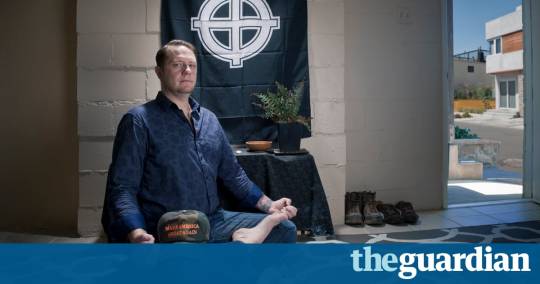
Every few weeks, William Johnson, the chairman of the white nationalist American Freedom Party (AFP), holds a lunch for members, the goal being to make America a white ethnostate, a project that begins with electing Donald Trump. This week, its at a grand old French restaurant called Taix, in Echo Park, Los Angeles an odd choice on the face of it. Echo Park is a trendy hood. Its hipster and heavily Hispanic. In fact, given the predominance of Latino kitchen staff in this city, it may be wise to hold off on the Trump talk until the food arrives.
About three months ago, Johnson begins, I was talking to Richard Spencer about how we need to plan for a Trump victory. Spencer is another prominent white nationalist he heads the generic-sounding National Policy Institute. I said: I want Jared Taylor [of American Renaissance] as UN Ambassador, and Kevin MacDonald [an evolutionary psychologist] as secretary of health and Ann Coulter as homeland security! And Spencer said: Oh Johnson, thats a pipe dream! But today, hed no longer say that, because if Trump wins, all the establishment Republicans, theyre gone They hate him! So whos left? If we can lobby, we can put our people in there.
Around the table five young men, roughly half Johnsons age (hes 61), nod and lean in. They all wear suits and ties, address the waiter as sir and identify as the alt right, the much-discussed nouvelle vague of racism. Are you guys familiar with the Plum Book? Johnson asks. Its plum because of the colour, but also because of the plum positions there are 20,000 jobs in that book that are open to a new administration.
So we need to identify our top people! says Eric, one of the men at the table.
Just anyone with a college degree! Johnson says.
Right. Eric is practically bouncing in his seat with excitement. We need to get the word out. We are the new GOP!
A whiter future: pro- and anti-Trump supporters clash outside Trump Towers in New York. Photograph: Alamy Stock Photo
Its not every day that a brown journalist gets to sit in on a white-nationalist strategy meeting. But these are strange times. Racism is trending. Like Brexit, Trump has normalised views that were once beyond the pale, and groups like the AFP have grown bold. Their mans stubby orange fingers are within reach of actual power, so maybe its time to emerge from the shadows at last.
I first met Johnson in May after he signed up as a Trump delegate before being swiftly struck off by the campaign when the press found out. Hes a surprising figure. An avid environmentalist, fluent in Japanese and, in person, not the bitter old racist Id expected but rather a jolly Mormon grandfather, bright eyed and chuckling, a Wind in the Willows character. Eric is even more unexpected. Tall and impassioned, he came to racism via hypnotherapy, of all things. He sells solar panels for a living and practises yoga. Together with his friends Matt and Nathan, who are also here at lunch, he runs an alt-right fraternity in Manhattan Beach a beer and barbecues thing. Theyre called the Beach Goys. Were starting a parody band, he beams. Weve found a drummer!
Between them they represent two poles of a racist spectrum, young and old. And judging from this lunch, its the millennials who are the more extreme. Johnson wants white nationalists to appear less mean and he finds the JQ, the Jewish Question, archaic. But Eric loves the meanness of the alt right. Were the troll army! he says. Were here to win. Were savage! And antisemitism is non-negotiable. In fact, hed like to clear up a misnomer about the alt right, propagated by the Breitbart columnist Milo Yiannopoulos, who is often described, mistakenly, as the movements leader. Milo casts the alt right as principally a trolling enterprise, dedicated to attacking liberal shibboleths for the lulz theres precious little actual bigotry. But Eric insists otherwise. Yes, they like to joke, they have memes, theyre just as funny as liberals have I heard of their satirical news podcasts, the Daily Shoah and Fash the Nation? But make no mistake, the racism is real. Eric especially enjoys The Daily Stormer, a leading alt-right news site, which is unashamedly pro-Hitler.
What unites Johnson and Eric is what they describe as the systematic browbeating of the white male namely all this talk of privilege, the Confederate flag, Black Lives Matter and mansplaining. But beyond that, its the looming extinction of the white race. This is the language they use. Also: Diversity equals white genocide. The alt right loves to evoke genocide while harbouring Holocaust deniers. Their point is that white people are melting away like the icecaps, and they have a primal drive to stop it. In 2044, non-Hispanic whites will drop below 50% of the US population. The generation of the white minority has already been born, Eric says. Look at South Africa and Rhodesia. Thats where were headed. Total disenfranchisement.
Mexican activists on the campaign trail. Photograph: Alamy Stock Photo
I want to reassure him that his Brown Rulers will be gentle and that slavery isnt so bad when you get used to it. But its not me they want to hear from, its white people. This is the white nationalists burden the very people theyre trying to save are the ones who most fiercely oppose them. The only group I cannot get along with is white people, says Johnson. Because white people hate white people who like white people.
A couple of days later, Johnson is at his cluttered desk in downtown LA, nattering merrily in Japanese to a woman in Tokyo. He gets lots of media requests these days, but especially from Japan. Theres an uncanny connection between Japan and white nationalism in America. Jared Taylor, white nationalisms foremost intellectual, is another fluent speaker. Its an ethnostate and its deeply nationalist, he says. And they have resisted the pressure to admit refugees. I say: God bless them!
For his part, Johnsons racism was shaped in Japan. He grew up in Eugene, Oregon, a state founded as a white utopia, in a modest Mormon home, back before the LDS church gave black people the priesthood in 1978. But it was his two-year mission to Tohoku, Japan, that turned him. As he went from door to door, locals would opine on the greatness of white America. They had an inferiority complex after the war, so we were treated like celebrities, he says. Oh, it was just the funnest time! A few years later, while working in Japan as an attorney, he wrote a book advocating the repatriation of all non-whites with appropriate reparations, because I thought America was going to collapse unless I did something. When he returned to LA, he sent a copy to every congressman. He was 32.
Clearly things didnt work out as planned. His forays into politics floundered and then his offices were bombed. So he retreated from activism for nearly 15 years, only returning in 2009 to form the AFP just in time for the rise of the alt right.
We head to his 67-acre ranch near Pasadena, a hilly lot backing on to a national forest. I asked to meet his family, but his wife refused, so we tour the farm instead his persimmon orchard, his horses and ducks. And there on his pick-up truck is a stencil of Jimi Hendrix. My daughter likes to paint, he says proudly. None of his five children are white nationalists, though they have promised to marry within the race.
Youre a white supremacist with a black artist painted on your truck, I tell him. And he flinches. Thats the meanest, most hurtful swearword there is. Just because I say different races have different strengths doesnt mean I think Im superior. He doesnt like racist either. Its a pejorative. I prefer race realist.
But its not my reality, Bill. Im sticking with racist.
Well, OK. But people who embrace racist are mad at everybody. I get along with people. You cannot function in Los Angeles without encountering other races, so I look for areas of similarity and agreement. Its important to treat everyone with the highest respect on a micro level.
I thought America was going to collapse unless I did something: William Johnson, chairman of the American Freedom Party, at home on his ranch near Pasadena. Photograph: Barry J Holmes for the Observer
On a macro level, however, darkness falls multiculturalism is doomed, the different races will never get along, and our only hope is Balkanisation: separate territories for separate tribes. And whatever accelerates that transition is welcome, even racial strife. I dont think friction is a good thing, he says, but it would help facilitate the split that is necessary.
We stop to feed his alpacas. Theres a brown one, a black one and a white one, standing peacefully together against the chicken wire fence.
See Bill, theyre getting along.
He laughs. I wish people were like alpacas.
Im with Eric at a Mexican restaurant in Manhattan Beach where he lives, an upscale, white neighbourhood in the South Bay. He clears space on the table and grins. OK, you ready? Your first tarot card reading with the Hitler Youth!
Its been an odd afternoon. We walked along the beach and I asked about his gmail address which includes the number 1488, a potent number for white supremacists. The 14 stands for the 14 words coined by the late David Lane of the group The Order: We must secure the existence of our people and a future for white children. And the 88 refers to HH (H being eighth in the alphabet) or Heil Hitler. Eric sighed. OK, but this stuffs hard to talk about, he said. It depends how red-pilled you are.
Alt-righters love talking about the red pill. Its a reference to The Matrix blue-pilled people bumble through a life of illusion, while the red-pilled have seen the truth and theres no turning back. Like all conspiracy theorists they see the hidden hand that guides all things, but for the alt right that hand is Jewish. The red pill is classic antisemitism, rebooted for a younger generation. As we walked, he laid it out the banking, the media, the globalism. We passed games of beach volleyball and family picnics, while he explained why the Holocaust was exaggerated and Hitler got a bad rap.
A nation without colour: William Johnson speaking at an AFP conference in 2013.
Have you noticed that kombucha isnt as fizzy as it used to be? he asks, along the way, because Eric isnt your average Nazi. He trained as a spiritualist. He has taught meditation. He brought his tarot cards in case I wanted a reading.
Dont tell me its the Jews, I tell him. He laughs. You said it, not me!
In the late 70s, the Klansman David Duke swapped his hood and robes for a suit and tie, and took white supremacy out of the cross-burning fields and into the boardroom. Mark Potok of the Southern Poverty Law Center describes the alt right in similar terms, as Racism 2.0, a rebranding for the digital generation. Its a trendy reboot alt right makes white supremacy sound like an art collective. And Eric, the kombucha Nazi, just takes it a step further into the aisles of Whole Foods. Hes a locally sourced, wild-caught bigot high in omega-3s and antisemitism. It makes him more sinister in some ways, and more harmless in others. As Nazis go.
Hmm, Nazi. Like Johnson, hes squeamish about terms. Warriors against political correctness can be awfully sensitive. Its such a slur, he says. But come on hes a Hitler apologist. OK, fine, he says. Just dont say Im a Buddhist, because Im actually more into Norse and Celtic mysticism now.
Itll come as no surprise that someone whod rather be called a Nazi than a Buddhist has a strange story to tell. Originally from a well-off white suburb of Chicago, he moved to Las Vegas to pursue music. Then one day, in the gym of his condo building, he met a guru figure well call Frank. A spiritualist and businessman, Frank introduced Eric to New Age mysticism and Japanese Buddhism. And it was under Franks guidance that Eric moved to LA to study hypnotherapy and began a career giving readings and tarot shows at a psychic bookshop. Frank, he says, was his mentor and best friend. But then Eric took a turn. He radicalised himself. He left the New Age life, finding it too feminine, and spiralled down a sinkhole of conspiracy theory. He and Frank have been estranged ever since. Frank is black.
By the book: author Ann Coulter. Photograph: Aaron Davidson/Getty Images
Today, Eric still meditates and practises yoga. His weeks are spent like David Brent, as a travelling salesman, driving around meeting his solar energy clients. His weekends, however, are all about the Beach Goys, which now has 15 members. Last week, they went on a hike to the Murphy Ranch in the Pacific Palisades, a decrepit old property that was originally built as a refuge for Hitler after the war. Next week is their first band rehearsal. Erics going to play guitar and sing. And this is the future he wants not a plum job with the Trump administration. I dont see myself as a bureaucrat, he says. I want to take the Beach Goys national. I want to inspire people.
It could happen. Trump has unleashed something in America. Johnson wont reveal the AFPs membership numbers Maybe we want to appear bigger than we are? but Eric insists the alt right is on the march. Were growing with every hashtag, every BLM protest, every city that becomes a Detroit, or a London, he says. Were everywhere! Were the guy next to you at yoga, the barista at Starbucks… Its like Fight Club for supremacists, a deeply unsettling thought (which is why Eric loves it).
But his delight in being a secret Nazi detracts from the seriousness of it all, the white genocide stuff. Hes having too much fun. And I wonder, as we finish our beers, if it will pass for Eric, this Nazi phase. He just doesnt seem that threatening. Then he starts up about a race war, that old white-supremacist chestnut. Because behind the trolling veneer, the alt right is more traditional than alt. What Eric believes is vintage racism, the same old wine in a new ironic cask. And Tony Benns words ring as true as ever: Every generation must fight the same battles again and again.
Our civilisation is at war and we need to secure our people, Eric says. We must seize power and take control. And the idea that we can do this peacefully is probably not realistic.
We get along well enough, Eric and I, but he has the same micro/macro discrepancy as Johnson. And at a macro level, there is only despair and division. I do not advocate violence, but I will give my life for my blood and for the honour of my ancestors.
He thrums the tarot cards in his hands, his voice getting more animated. We accept the game thats being played. We accept that the lion and the gazelle are competition. But they dont have to hate each other. Thats just how we view it.
He shrugs. Its scary. The world is scary. This is not a game for children.
from All Of Beer http://allofbeer.com/call-me-a-racist-but-dont-say-im-a-buddhist-americas-alt-right/
0 notes
